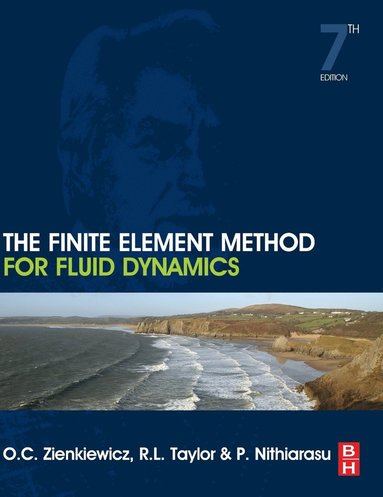
- Format
- EPUB
- Språk
- Engelska
- Serie
- Finite Element Method
- Antal sidor
- 584
- Utgivningsdatum
- 2013-12-17
- Upplaga
- 7
- Förlag
- Elsevier Science & Technology
- Medarbetare
- Taylor, R. L. / Nithiarasu, P.
- Dimensioner
- 243 x 194 x 33 mm
- Vikt
- Antal komponenter
- 1
- ISBN
- 9781856176354
- 1335 g
Finite Element Method for Fluid Dynamics
- Skickas från oss inom 7-10 vardagar.
- Fri frakt över 249 kr för privatkunder i Sverige.
Passar bra ihop
De som köpt den här boken har ofta också köpt Atmosphere av Taylor Jenkins Reid, Taylor Jenkins Reid (häftad).
Köp båda 2 för 1523 krKundrecensioner
Fler böcker av författarna
-
Finite Elements and Approximation
John N Rossettos, O C Zienkiewicz, K Morgan, O C Zienkiewicz
-
Finite Element Method: Its Basis and Fundamentals
O C Zienkiewicz, R L Taylor
-
Finite Element Method for Solid and Structural Mechanics
O C Zienkiewicz, R L Taylor
-
Finite Element Method Set
O C Zienkiewicz, R L Taylor
Recensioner i media
Reviews from the previous edition:"...this is a book that you simply cannot afford to be without." --INTERNATIONAL JOURNAL OF NUMERICAL METHODS IN ENGINEERING
Övrig information
Professor O.C. Zienkiewicz, CBE, FRS, FREng died on 2 January 2009. Prior to his death he was Professor Emeritus at the Civil and Computational Engineering Centre, University of Wales Swansea and previously was Director of the Institute for Numerical Methods in Engineering at the University of Wales Swansea, UK. He also held the UNESCO Chair of Numerical Methods in Engineering at the Technical University of Catalunya, Barcelona, Spain. He was the head of the Civil Engineering Department at the University of Wales Swansea between 1961 and 1989. During this period he established that department as one of the primary centres of finite element research. In 1968 he became the Founder Editor of the International Journal for Numerical Methods in Engineering which still remains today the major journal in this field. The recipient of 27 honorary degrees and many medals, Professor Zienkiewicz was a member of five academies - an honour he received for his many contributions to the fundamental developments of the finite element method. In 1978, he became a Fellow of the Royal Society and the Royal Academy of Engineering. This was followed by his election as a foreign member to the US National Academy of Engineering (1981), the Polish Academy of Science (1985), the Chinese Academy of Sciences (1998), and the National Academy of Science, Italy (Academia dei Lincei) (1999). He published the first edition of this book in 1967 and it remained the only book on the subject until 1971. Professor R.L. Taylor has more than 60 years of experience in the modelling and simulation of structures and solid continua including eighteen years in industry. He is Professor of the Graduate School and the Emeritus T.Y. and Margaret Lin Professor of Engineering at the University of California, Berkeley and also Corporate Fellow at Dassault Systèmes Americas Corp. in Johnston, Rhode Island. In 1991 he was elected to membership in the US National Academy of Engineering in recognition of his educational and research contributions to the field of computational mechanics. Professor Taylor is a Fellow of the US Association for Computational Mechanics - USACM (1996) and a Fellow of the International Association of Computational Mechanics - IACM (1998). He has received numerous awards including the Berkeley Citation, the highest honour awarded by the University of California, Berkeley, the USACM John von Neumann Medal, the IACM Gauss-Newton Congress Medal and a Dr.-Ingenieur ehrenhalber awarded by the Technical University of Hannover, Germany. Professor Taylor has written several computer programs for finite element analysis of structural and non-structural systems, one of which, FEAP, is used world-wide in education and research environments. A personal version, FEAPpv, available on GitHub, is incorporated into this book. P. Nithiarasu is Professor at Zienkiewicz Institute for Modelling, Data and AI and Associate Dean for Research, Innovation and Impact, Faculty of Science and Engineering, Swansea University. Previously he has served as the Head of Zienkiewicz Centre for Computational Engineering, Deputy Head of College of Engineering and Dean of Academic Leadership. He was awarded the Zienkiewicz silver medal from the ICE London in 2002, the ECCOMAS Young Investigator award in 2004, and the prestigious EPSRC Advanced Fellowship in 2006.
Innehållsförteckning
1. Introduction to the Equations of Fluid Dynamics and the Finite Element Approximation2. Convection-Dominated Problems: Finite Element Approximations to the Convection-Diffusion-Reaction Equation3. The Characteristic-Based Split (CBS) Algorithm: A General Procedure for Compressible and Incompressible Flow4. Incompressible Newtonian Laminar Flows5. Incompressible Non-Newtonian Flows6. Free Surface and Buoyancy Driven Flows7. Compressible High-Speed Gas Flow8. Turbulent Flows9. Generalized Flow and Heat Transfer in Porous Media10. Shallow-Water Problems11. Long and Medium Waves12. Short Waves13. Fluid-Structure Interaction14. Biofluid Dynamics15. Computer Implementation of the CBS Algorithm
Du kanske gillar
-
Proto
Laura Spinney
Häftad -
Nexus
Yuval Noah Harari
Häftad


